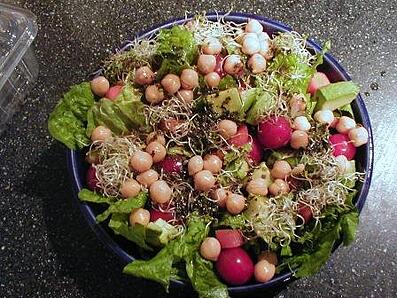A vegetarian diet can be a very healthy diet that is higher in fiber and antioxidants while being lower in calories, cholesterol and saturated fat. But because it does exclude certain foods, it takes some extra planning.

If you are going vegetarian, you’ll want to pay special attention to these five nutrients:
- Protein
- Iron
- Calcium
- Zinc
- B12
Today we will focus on protein.
Proteins play a super important role in the body. They are found in every cell of the body, can build and repair cells, form muscle, build hormones, form antibodies for your immune system and even stimulate important reactions in the body in the form of enzymes.
Proteins are made up of different sequences of amino acids, which are often referred to as the “building blocks” of the body. Although your body does a really good job at making eleven of the twenty amino acids, there are nine of them that you need to get from food because your body does not have the ability to form them. These are called ‘essential amino acids’. These amino acids are crucial in building the wide variety of proteins in the body.
Animal foods like fish, poultry, meat, eggs, and dairy contain all nine of these amino acids. Because of this, they are referred to as ‘complete proteins.’ They are also referred to as ‘high biological value proteins.’ Soy also falls into this category.
On a vegetarian diet the vast majority of these complete proteins are no longer available, but that doesn’t mean vegetarians won’t be able to get all nine of those essential amino acids. It just means that it will take some planning.
Use variety as a stand-in for the complete proteins in meat.

Although plant foods aren’t ‘complete proteins’ they do contain a variety of amino acids. You can find amino acids in nuts, seeds, peas, lentils, grains, vegetables, and even fruit. They just vary in amounts, type, and availability.
Regardless of where your proteins come from, when they are digested, your body will break them down into individual amino acids. Once broken down, they essentially enter an ‘amino acid pool’. DNA then guides the body to align strings of these amino acids from the pool in a specific order so that they can form different proteins with different functions.
Whether you get all of these amino acids from one food or from a variety of different foods, it doesn’t necessarily matter, as long as you have all nine of the amino acids present in the right amounts.
Not sure how much protein you need to consume? The Centers for Disease Control & Prevention has published some general guidelines by age group here.
So, our key take away message is: Focus on a variety of different types of vegetarian foods so you can get the full spectrum of essential amino acids! And be sure to work more protein-dense plant foods into your diet (like lentils, nuts, and seeds).
Great Harvest has compiled some information about the nutritional benefits of whole grains. Learn more about how whole grains can help you get enough protein, even on a vegetarian diet.
Read related posts on The Bread Business Blog:
- Whole Grain Carbs and Protein Should Fuel Your Workouts
- How to Fuel Your Workouts with Whole Grains, Protein, and More
Image credits:
Salad bowl photo credit: moria via photopin ccVegetarian photo credit: juanvegano via photopin cc





